
Off The Hook: Telstra Customer Insight Centre
This isn’t so much a story about an AV ‘Disneyland’ as it is about who designed and integrated it.
Text:/ Christopher Holder
Telstra is the 300-pound gorilla at the AV dinner party. Up until now it was contentedly doing it own thing — munching on telco bananas in the corner — but now it’s decided it wants a place at the table and it stands to reason some other ‘guests’ will have to make way.
If you want proof as to just how serious Telstra is about moving into the AV space then look no further than the Customer Insight Centre (CIC). No other integrator or supplier in this region has the wherewithal to come close to the ambition of this showpiece. There’s nothing quite like it — certainly not in Australia; not in the Asia Pacific region; and it’s in elite company worldwide. What’s more, it’s all the result of Telstra expertise. Sure, specialist know-how has been brought in for various aspects (like any ambitious project) but Telstra has designed, integrated and installed everything you see at the CIC.
DON’T WASTE MY TIME
The CIC is not Telstra’s first rodeo — there have been other customer ‘inspiration’ and ‘experience’ centres before it — but this centre is a result of Telstra’s most recent market feedback. Mostly what they’ve been hearing from clients is: “don’t waste our time”.
“Our customers’ feedback has been: we want value for time,” noted CIC General Manager David Woodbridge. “So when a client says they’re going to spend some time with Telstra — an hour, a day or three days — they want to ensure they’re getting value out of it. And looking at the traditional demonstration spaces, they just weren’t cutting it. Effectively we are now competing with Google search: it’s easy to look up a product or watch a demonstration video, find information and pricing. We needed to provide something more.”
And thus the Customer Insight Centre was born. More than an ‘experience’, more than a provider of ‘inspiration’, the CIC is a veritable blank AV canvas to paint a story specifically designed and researched for Telstra customers in their market sector.
From the moment the client arrives on Level 2 of the George Street building, they embark on a bespoke journey. The Telstra team has already prepared a ‘playbook’ to ensure the customer’s experience is relevant to them; that the centre addresses the questions pertinent to their business.
At the back end, the playbook is driven by a purpose-built CMS that allows Telstra to push content to the right screen at the right time. Content is also triggered via beacons communicating with tablets provided to delegates, and/or via RFID in the client’s name badge.
“So if Coca-Cola came in here, all of the screens would change to Coca-Cola,” explained Woodbridge. “Ten minutes later you might have Qantas coming through and all the screens instantly change to be Qantas-focussed. It means we don’t have to spend the time managing the screen content; the playbook can be prepared in advance.”
The in-house AV team is constantly on a Defcon 1 state of alert. The stakes are high, as are the standards — if you’re relying on your AV to blow people away, a dead display or a glitchy touchscreen interface means much more than an embarrassed quip and a “technology is nice when it works” rejoinder. It could potentially scupper a million-dollar deal. The in-house team has invested heavily in its own AMX programming. The new interface is instantly recognisable as ‘Telstra’ but stripped of all but what’s necessary for that room. A boardroom video conference will be ready in no more than three minutes, for example. That’s the guarantee. The CIC is Telstra’s way of saying to blue-chip CTOs: “We know your business. We know technology. We can do this. We’re your end-to-end solution provider.”
Andrew Calov is Telstra’s lead AV architect and a man unwilling to endure the AV status quo for any length of time. Whether you knew it or not, Andrew and his team have been doing high-level integration work for some time now. Up to this point you may not have heard about the job because it’s more often than not servicing key Telstra clients and it didn’t go out to tender. But trust me, he leads a force to be reckoned with.
(SYSTEMS) INTEGRATION
The CIC is undoubtedly impressive but is it really more than the plaything of a corporate giant? Does it really pay for itself? Andrew Calov is adamant it does:
“Take the example of our CIC boardroom. Prior to visiting, the conversation quite often doesn’t go much beyond: ‘how much for a boardroom?’. But that changes when people are here and quite spontaneously they start thinking of ideas. We had one of the big banks in here recently discussing activity-based working, and they had an idea, where we could install a CO2 sensor to determine how many people were in the meeting room. Then they could send an email saying ‘please don’t book this room with only three people attending’. It’s becoming a science and the results are a more efficient use of space.”
Like any good showroom, the CIC gets people to buy with their eyes, what’s more, it reveals the extent of Telstra’s expertise: “Let me get this straight; you can do all this?” And it can — from initial consultancy services through to needs analysis, change management and transition, with technology and integration in between.
Andrew Calov again: “I’m very passionate about the AV industry. I would like to see everyone doing better work — that’s good for the whole industry, everyone going beyond what they’re currently doing. It’s my opinion that the AV industry has been really quite stagnant in the last five years or more. We haven’t seen a lot of innovation but now we’re definitely encouraging some thinking outside the box.
“We are moving towards an internet of things, which sounds a bit odd in the AV world but that’s where the AV industry is going, integrating all sorts of unconventional devices — recently we were asked to integrate a fridge. In fact, the AV will soon be taken out of AV Integration, it will soon just be integration. It’s all about the built environment and whatever has an IP address and an API, we’re going to be asked to talk to it.
“Quite often our competitors are reactive rather than proactive; only doing what’s asked and no more. Telstra is more about ‘what can we do with the technology?’ and exploring the future path with our clients — testing the boundaries and challenging people’s perceptions.”
CONTACTS
Meyer Sound: (07) 3267 7800 or www.meyersound.com.au
Digital Place Solutions (NanoLumens): 0412 339 489 or gerry@digitalplacesolutions.com
Arup: (03) 9668 5500 or www.arup.com
PAVT (ClearOne): (03) 9264 8000 or sales@productionaudio.com.au
Lightware: www.lightware.com.au
Sony Professional: (02) 9887 0586 or amanda.aldridge@ap.sony.com
Axis Audio (Analog Way): www.axisav.com.au
Jands (BSS): (02) 9582 0909 or info@jands.com.au
BOARDROOM
Telstra’s vision of a modern boardroom is hi-tech, high-design and just a little bit playful. A QR code is designed into the carpet (yes, it will take you to the Telstra site) and a LED curtain provides some colour-changing life. From a technology standpoint, the Cisco camera tracking system is a drawcard, with its ability to triangulate whoever’s holding the floor, and via facial recognition recall and track a presenter’s position around the table.
Although ClearOne’s microphone beamforming systems are used elsewhere in the CIC, the boardroom advocates table-embedded microphones, while Extron laptop interfaces are neatly integrated into the table as well.
Automation reigns supreme, everything from the lights to the blinds, the VC and the presentation facilities, via AMX touch and Telstra’s distinctive control GUI.

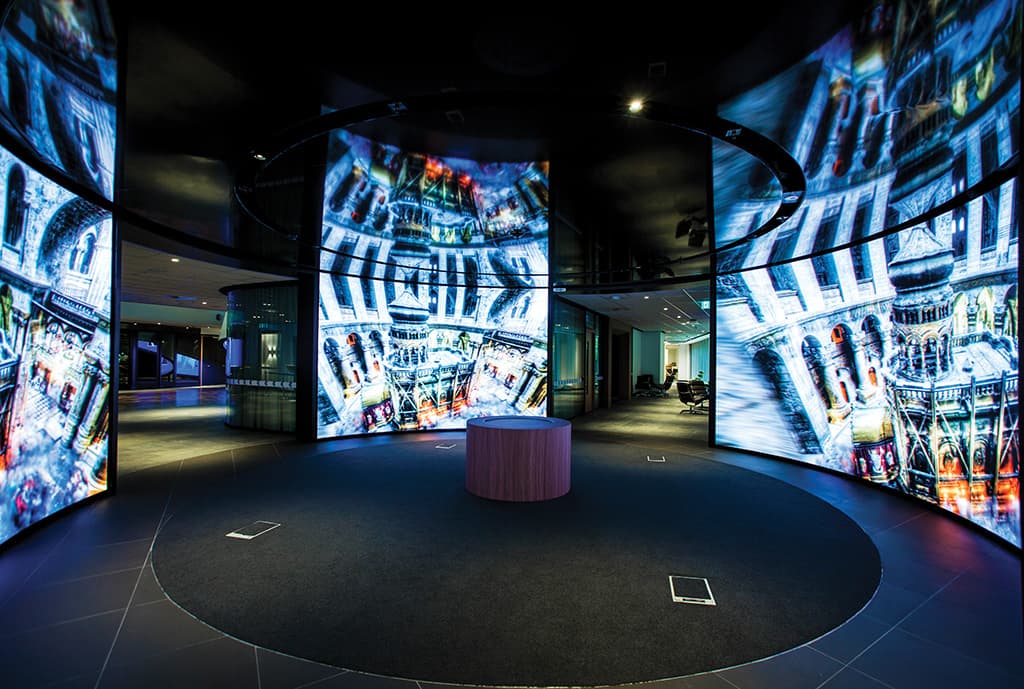
PARTNERSHIP HUB
Welcome to the Partnership Hub. It’s a zone for delegates to be wow’ed by the breadth of strategic partnerships and subsidiaries Telstra has in its worldwide corporate orbit. For example, Telstra recently acquired PacNet, and the Hub can graphically demonstrate how its reach has increased markedly in the Far East.
“It goes back to shifting expectations,” noted David Woodbridge. “We want to have a conversation with clients, we don’t want to stand in front of a presentation, and the Partnership Hub provides the inspirational environment to have that conversation. Even the most hard-headed CFO will get a little bit excited and a little more engaged. Much more than if you clicked through a PowerPoint.”
The Stonehenge-like assembly of three 3m-high 4.5mm pixel-pitch NanoCurve displays from NanoLumens go from the floor to a reflective ceiling and create an immersive space where product and services solutions take on both intimacy and immediacy. It’s also a great area to play PlayStation (apparently!). The subwoofer concealed in the centre seating works a treat.
EXHIBITION SPACE
This flexible exhibition space can be easily reset to demonstrate how a business might ‘go digital’. The team can highlight a certain solution — from signage, to interactive touch, to payment gateways — and allow delegates to literally ‘walk through’ a concept. David Woodbridge describes the thinking behind the ‘blank canvas’ nature of the space: “We’ve learnt from previous centres not to build anything permanent — they quickly get dusty and uninspiring. We had a Big Four bank through here, we’ve had a surf shop, we had a school, and in each case we put the sets in, then overlaid them with technology. It tells the customer engagement story. So rather than the space being a permanent hospital or school, it’s a supremely flexible environment.”


DREAM THEATRE
With its Meyer Sound Constellation variable acoustics surround sound system and huge NanoLumens 4K LED screen on stage, the CIC 300-seat Theatre is truly one of a kind.
“There’s actually one other like it in the world,” demurred CIC Manager David Woodbridge, “that has the Meyer Constellation system and a 4K video wall.”
Meyer Constellation addresses a problem most performance venues suffer from: the need for multi-functionality. The problem is, multi-function venues often end up being ‘no-function’ venues — at least from an acoustical perspective. Aside for the likes of the thoroughbred opera house or concert hall, most performing arts centres need to be as adept at hosting theatre, one-man comedy shows, cinema and rock ’n’ roll as it might be staging deb balls or travelling opera shows. The staging and lighting might be able to cope with the diverse roster, but the acoustics don’t. A concert hall needs around 12 cubic metres per patron to achieve anything like an optimal acoustic for a symphony orchestra to bloom, while spoken word is best appreciated in a smaller/deader space with a commensurate ~5 cubic metres per patron. The ‘happy medium’ acoustic of most performance venues is not happy at all.
Constellation’s pitch is that it can electronically provide you with the perfect room acoustic, best suited to the application. It’s a seriously tech-heavy solution. It’s certainly not just a fancy surround sound system — there are far cheaper ways of setting up a hi-spec multi-channel audio system for flying sound around a room — Dolby Atmos or Barco Auro for a start. No, multi-channel surround is more of a byproduct of the setup rather than the main game.
To be clear, constellation is not an artificial reverberation system, yet Constellation can change the apparent acoustics of the room, electronically. Here’s how: a matrix of dozens of DPA reference microphones ‘sniff’ or ‘sample’ the room in real time, feeding into a powerful Meyer D-Mitri DSP mainframe (the brain of Constellation). A newly-generated soundfield, created in a natural manner by adding many finely-tuned delays to the input, is output through a multitude of critically-placed Meyer Sound loudspeakers.
It’s enormously DSP-intensive but the results are truly spectacular. Constellation’s synthesised delays interact in a way that mimics real-world audio and become a natural component of the room’s resulting reverberant field, as treated audio blends with the room’s original audio. It’s not simply about hearing the performer in the right environment, you as the patron share that same space — rustle your packet of Jaffas, or sneeze, and you hear yourself in the same ‘concert hall’ or ‘cinema’.
The microphone and speaker positions, together with processing calibration ensure that feedback and phase cancellation are not issues. In fact, such is the sensitivity of the system that the theatre’s AV team mostly don’t bother with a lav or headset for on-stage presenters, rather, they’ll rely on the Constellation’s microphones to capture speech, which will be happily output to the system in a way that sounds utterly natural. Saying that, Anthony Lorraine, the Chief Theatre Technology Manager can virtually place the gathered delegates into a bathroom, the Grand Canyon or the acoustics of anywhere in between with the click of a mouse. Constellation’s CueStation control software has a Space Map feature that allows Anthony to map the theatre and draw in a custom panning curve — something impressively evident when he allowed the speakers and subs to stretch their legs with a thunderstorm location recording that rippled dramatically around the room.
In audio terms, Constellation is the showstopper, it’s up there with the master conjurer making the Statue of Liberty disappear. Credit must go to the consultants, Arup — initially led by Nathan Blum and then Ben Moore, and to the system designer (the audio luminary, Bob McCarthy). You have to hear it to believe it, and even when you do, you’re left shaking your head in amazement.
The hugely impressive NanoLumens NanoSlim Engage 2.5mm native 4K on-stage display (NanoLumens’ new hi-res, large-scale visualisation solution), is forced to play the role of technical bridesmaid. But there’s no doubting the 8.5m x 6.2m display is the room’s visual focus. For events such as the 2015 ARIA nominations announcement the display comes into its own. It’s impossible to pull your eyes away from the stage.
An Analog Way Ascender 32 vision processor makes it easier for the theatre staff to drag ’n’ drop as many as eight PIPs on screen. There are some 30 inputs including SDI, the rarely used VGA, DVI, DisplayPort, and the six in-house Sony BRC-H900 PTZ cameras, with up to 12 inputs selectable at any one time. Any of those sources can then be moved around the screen with a mouse. A Lightware 4K matrix switcher does more of the heavy lifting in the machine room. The simplicity of the Ascender 32 interface belies the grunt required to ensure glitch-free operation.
Anthony Lorraine: “We have to be versatile. I had a simple videoconference this morning with five or 10 sites. In those circumstances there may only be three of us: a stage manager, myself, and someone else on the mixing console manning the lapels. At the other extreme we might have a whole-day bump in, 30-odd people on crew, we might be producing broadcast feeds, a different operator on cameras, media, lighting, sound etc.”
It’s one helluva fancy video conferencing space. But with the Sony PTZ cameras, ClearOne VC systems and BSS echo cancelling DSP, the theatre happily slums it for ‘townhall’ meetings and the like. There are DVM capabilities, which means Telstra can share content with as many as 70 possible broadcast destinations, including Fox, free-to-air channels, Chief and others. The DVM capabilities also mean Telstra can set up super-high bandwidth video conferences between its main offices.

RING TONE
The Insight Ring is a remarkable piece of display technology and design. It dominates the floor. Impossible to ignore, it immediately puts customers on high alert: this session is going to be much more than ‘death by Powerpoint’ and ‘these guys clearly know technology’.
The ring beckons, you just want to get inside it. It’s like some sort of ‘stargate’ — an alien space/time portal — promising a glimpse into another dimension, which isn’t so far from the truth.
In it Telstra can accommodate a single delegate or 20+, with the media team providing industry insights pertinent to the client’s industry. The experience is truly immersive, with the NanoLumens 4mm pixel pitch LED working with a multichannel audio system.
The Telstra team approached NanoLumens with the original concept — a circle tilted at 17° — designed to appear as if it was hanging in free space. The drawings were sent to NanoLumens HQ in Atlanta for a detailed engineering solution.
Doug Price, Director of Systems Engineering: “The tilt places a lot more stress on the structure than a regular ‘flat’ ring — with the 17° tilt it can distort under its own weight. Any distortion would cause a misalignment in the pixels. And at a 4.5mm pixel pitch it only takes half a millimetre before you see a distortion.”
Part of the answer was to keep weight to an absolute minimum and be utterly precise with the rigging — Doug and his team managed to pare down the number of rigging points from eight to two while maintaining the structural integrity. In fact, a last-minute curve ball — the outer shroud ended up being supplied quite a bit heavier than anticipated — was absorbed by the engineering.
One of NanoLumens’ hallmarks, as a specialist indoor LED provider, is how cool its panels run, which was a crucial consideration in this case — a dozen business suits will warm up quickly but noise from cooling fans would detract from the experience. Without a lot of ambient light the screens’ output need only tick over at around 25% of their possible output. Combine that with NanoLumens’ 82% efficiency and you have a display that’s cool to the touch.
Another key aspect of Nanolumens winning the job was in its colour rendering. As you can imagine, colour is everything in corporate branding, so not only must the panels represent the specific Pantone with accuracy, that accuracy must be maintained from panel-to-panel and at virtually any viewing angle. Remarkably, as you stand inside the 4m-across ring with LED in all directions, there’s no discernible colour shift.
Digital Place Solutions (Nanolumens): 0412 339 489 or gerry@digitalplacesolutions.com

STUDIO
The CIC Studio is a fully 4K-ready broadcast studio, and a Sony Professional showcase, of sorts.
One headturning product is the Sony NXL-IP55 IP Live Production Unit. The NXL-IP55 enables multiple video data streams to be transmitted over an IP Local Area Network (LAN) — up to four video streams (three downstream and one up, or two down/two up). The system maintains broadcast quality full HD video over the IP network. There are 2 x NXLIP55 deployed in the project installation. One is located in the CIC, the other is at Chief Entertainment studio across town. The pairing meets Telstra’s requirement for a direct link between the two studios. It also allows remote control and communication at full broadcast quality.
Two types of Sony broadcast cameras are being used: 4 x HSC300R and the HDCP1 ‘box’-type HD camera that can be used standalone as well as part of an integration.
A Yamaha CL series digital mixer takes care of audio.
The CIC theatre and broadcast studio are linked via a comprehensive Riedel comms system, comprising two Riedel Artist digital intercom matrices and an Acrobat digital wireless intercom system. Within the theatre, one Artist digital matrix intercom system facilitates production team communications during presentations. The theatre’s Artist matrix is linked via fibre to a second Artist matrix installed in the broadcast studio. With clear, continuous communications, staff in either the studio or the Theatre can direct and call events and broadcasts. The Riedel Acrobat system provides wireless coverage to both the studio and the theatre so that production staff and crew can work across both venues simultaneously.
Sony Professional: pro.sony.com.au
Riedel: riedel.net
Yamaha: yamahaproaudio.com
RACK ROOM HIGHLIGHTS
- 3 communication rooms with 35 racks to house network, collaboration and content gear
- 55 virtual machines, 27TB of conventional storage and 8TB of high performance flash storage installed
- A core network that provides 11.5 Tbps switching capacity
- Lightware 160×160 4K video/audio matrix was the first ordered in the world
- 86km of underfloor cable including 20km of fibreoptic

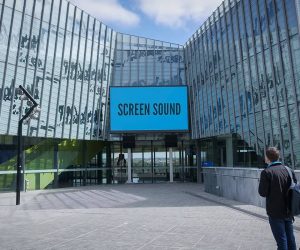
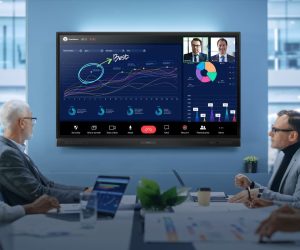
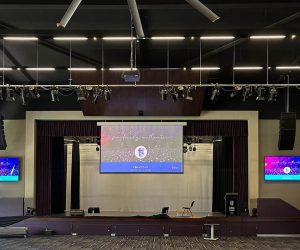

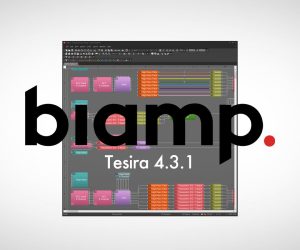

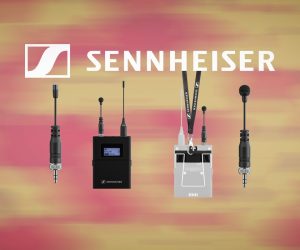
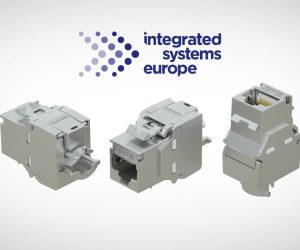
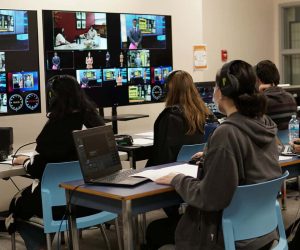
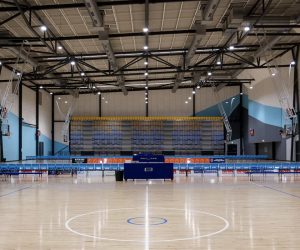
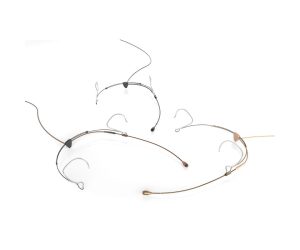
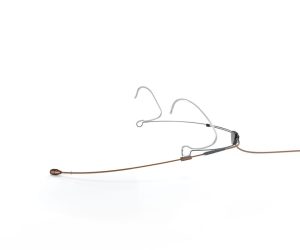


RESPONSES